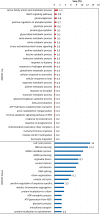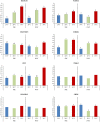Transcriptomic Analysis Reveals Insights on Male Infertility in Octopus maya Under Chronic Thermal Stress
- PMID: 30697164
- PMCID: PMC6341066
- DOI: 10.3389/fphys.2018.01920
Transcriptomic Analysis Reveals Insights on Male Infertility in Octopus maya Under Chronic Thermal Stress
Abstract
Octopus maya endemic to the Yucatan Peninsula, Mexico, is an ectotherm organism particularly temperature-sensitive. Studies in O. maya females show that temperatures above 27°C reduce the number of eggs per spawn, fertilization rate and the viability of embryos. High temperatures also reduce the male reproductive performance and success. However, the molecular mechanisms are still unknown. The transcriptomic profiles of testes from thermally stressed (30°C) and not stressed (24°C) adult male octopuses were compared, before and after mating to understand the molecular bases involved in the low reproductive performance at high temperature. The testis paired-end cDNA libraries were sequenced using the Illumina MiSeq platform. Then, the transcriptome was assembled de novo using Trinity software. A total of 53,214,611 high-quality paired reads were used to reconstruct 85,249 transcripts and 77,661 unigenes with an N50 of 889 bp length. Later, 13,154 transcripts were annotated implementing Blastx searches in the UniProt database. Differential expression analysis revealed 1,881 transcripts with significant difference among treatments. Functional annotation and pathway mapping of differential expressed transcripts revealed significant enrichment for biological processes involved in spermatogenesis, gamete generation, germ cell development, spermatid development and differentiation, response to stress, inflammatory response and apoptosis. Remarkably, the transcripts encoding genes such as ZMYND15, KLHL10, TDRD1, TSSK2 and DNAJB13, which are linked to male infertility in other species, were differentially expressed among the treatments. The expression levels of these key genes, involved in sperm motility and spermatogenesis were validated by quantitative real-time PCR. The results suggest that the reduction in male fertility at high temperature can be related to alterations in spermatozoa development and motility.
Keywords: RNA-Seq; chronic thermal stress; inflammation; male infertility; reproduction.
Figures










Similar articles
-
Oviducal gland transcriptomics of Octopus maya through physiological stages and the negative effects of temperature on fertilization.PeerJ. 2022 Mar 30;10:e12895. doi: 10.7717/peerj.12895. eCollection 2022. PeerJ. 2022. PMID: 35378931 Free PMC article.
-
Chronic thermal stress on Octopus maya embryos down-regulates epigenome-related genes and those involved in the nervous system development and morphogenesis.Comp Biochem Physiol Part D Genomics Proteomics. 2024 Dec;52:101332. doi: 10.1016/j.cbd.2024.101332. Epub 2024 Sep 28. Comp Biochem Physiol Part D Genomics Proteomics. 2024. PMID: 39366120
-
De novo transcriptome sequencing and gene expression profiling of Magnolia wufengensis in response to cold stress.BMC Plant Biol. 2019 Jul 18;19(1):321. doi: 10.1186/s12870-019-1933-5. BMC Plant Biol. 2019. PMID: 31319815 Free PMC article.
-
De novo assembly of the transcriptome of Acanthaster planci testes.Mol Ecol Resour. 2015 Jul;15(4):953-66. doi: 10.1111/1755-0998.12360. Epub 2014 Dec 25. Mol Ecol Resour. 2015. PMID: 25494938
-
Current status of sperm functional genomics and its diagnostic potential of fertility in bovine (Bos taurus).Syst Biol Reprod Med. 2018 Dec;64(6):484-501. doi: 10.1080/19396368.2018.1444816. Epub 2018 Mar 14. Syst Biol Reprod Med. 2018. PMID: 29537884 Review.
Cited by
-
Morphology, Histology, and Transcriptome Analysis of Gonadal Development in Octopus minor (Sasaki, 1920).Mar Biotechnol (NY). 2023 Dec;25(6):1043-1056. doi: 10.1007/s10126-023-10258-9. Epub 2023 Oct 25. Mar Biotechnol (NY). 2023. PMID: 37878213
-
The expanded inhibitor of apoptosis gene family in oysters possesses novel domain architectures and may play diverse roles in apoptosis following immune challenge.BMC Genomics. 2022 Mar 12;23(1):201. doi: 10.1186/s12864-021-08233-6. BMC Genomics. 2022. PMID: 35279090 Free PMC article.
-
Oviducal gland transcriptomics of Octopus maya through physiological stages and the negative effects of temperature on fertilization.PeerJ. 2022 Mar 30;10:e12895. doi: 10.7717/peerj.12895. eCollection 2022. PeerJ. 2022. PMID: 35378931 Free PMC article.
-
The hard life of an octopus embryo is seen through gene expression, energy metabolism, and its ability to neutralize radical oxygen species.Sci Rep. 2024 Jul 17;14(1):16510. doi: 10.1038/s41598-024-67335-9. Sci Rep. 2024. PMID: 39020012 Free PMC article.
References
-
- Akmal M., Aulanni’am A., Widodo M. A., Sumitro S. B., Purnomo B. B. (2016). The important role of protamine in spermatogenesis and quality of sperm: a mini review. Asian Pac. J. Reprod. 5 357–360. 10.1016/j.apjr.2016.07.013 - DOI
-
- Andrews P. L. R., Darmaillacq A. S., Dennison N., Gleadall I. G., Hawkins P., Messenger J. B., et al. (2013). The identification and management of pain, suffering and distress in cephalopods, including anaesthesia, analgesia and humane killing. J. Exp. Mar. Bio. Ecol. 447 460–464. 10.1016/j.jembe.2013.02.010 - DOI
LinkOut - more resources
Full Text Sources

